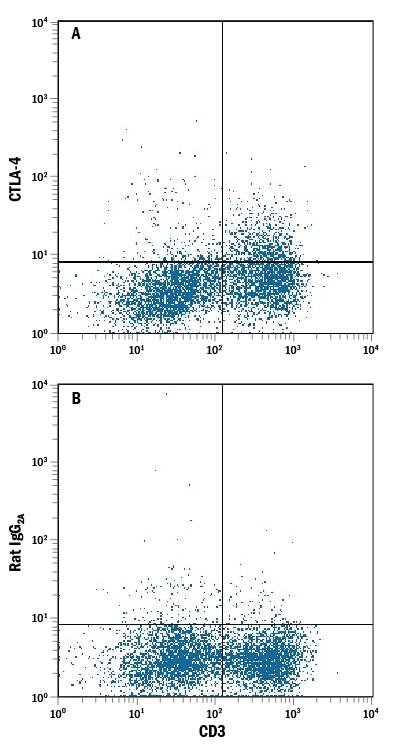Mouse CTLA-4 Fluorescein-conjugated Antibody
Mouse CTLA-4 Fluorescein-conjugated Antibody Summary
Ala36-Phe161
Accession # XP_001479180
Applications
Please Note: Optimal dilutions should be determined by each laboratory for each application. General Protocols are available in the Technical Information section on our website.
Scientific Data
 View Larger
View Larger
Detection of CTLA‑4 in Mouse Splenocytes by Flow Cytometry. Mouse splenocytes treated with Concanavalin A for 48 hours were stained with Rat Anti-Mouse CD3 APC-conjugated Monoclonal Antibody (Catalog # FAB4841A) and either (A) Rat Anti-Mouse CTLA-4 Fluorescein-conjugated Monoclonal Antibody (Catalog # FAB434F) or (B) Rat IgG2AFluorescein Isotype Control (Catalog # IC006F). View our protocol for Staining Membrane-associated Proteins.
Reconstitution Calculator
Preparation and Storage
- 12 months from date of receipt, 2 to 8 °C as supplied.
Background: CTLA-4
CTLA-4 and CD28, together with their ligands B7-1 and B7-2, constitute one of the dominant costimulatory pathways that regulate T and B cell responses. CTLA-4 and CD28 are structurally homologous molecules that are members of the immunoglobulin (Ig) gene superfamily. Both CTLA-4 and CD28 are composed of a single Ig V‑like extracellular domain, a transmembrane domain and an intracellular domain. CTLA-4 and CD28 are both expressed on the cell surface as disulfide-linked homodimers or as monomers. The genes encoding these two molecules are closely linked on human chromosome 2. CTLA-4 was originally identified as a gene that was specifically expressed by cytotoxic T lymphocytes. However, CTLA-4 transcripts have since been found in both Th1 and Th2, and CD4+ and CD8+ T cell clones. Whereas, CD28 expression is constitutive on the surfaces of 95% of CD4+ T cells and 50% of CD8+ T cells and is down regulated upon T cell activation, CTLA-4 expression is upregulated rapidly following T cell activation and peaks approximately 24 hours following activation. Although both CTLA-4 and CD28 can bind to the same ligands, CTLA-4 binds to B7-1 and B7-2 with 20-100-fold higher affinity than CD28. The physiological role of CTLA-4 in T cell costimulation is currently being studied. Recombinant human or mouse CTLA-4/Fc chimera preparations produced at R&D Systems have been shown to bind both B7-1 and B7-2 with high affinity and to inhibit CD28 signalling competitively.
Product Datasheets
Citation for Mouse CTLA-4 Fluorescein-conjugated Antibody
R&D Systems personnel manually curate a database that contains references using R&D Systems products. The data collected includes not only links to publications in PubMed, but also provides information about sample types, species, and experimental conditions.
1 Citation: Showing 1 - 1
-
Patterns of Expression of Vaginal T-Cell Activation Markers during Estrogen-Maintained Vaginal Candidiasis.
Authors: Al-Sadeq A, Hamad M, Abu-Elteen K
Allergy Asthma Clin Immunol, 2008-12-15;4(4):157-63.
Species: Mouse
Sample Types: Whole Cells
Applications: Flow Cytometry
FAQs
No product specific FAQs exist for this product, however you may
View all Antibody FAQsReviews for Mouse CTLA-4 Fluorescein-conjugated Antibody
There are currently no reviews for this product. Be the first to review Mouse CTLA-4 Fluorescein-conjugated Antibody and earn rewards!
Have you used Mouse CTLA-4 Fluorescein-conjugated Antibody?
Submit a review and receive an Amazon gift card.
$25/€18/£15/$25CAN/¥75 Yuan/¥2500 Yen for a review with an image
$10/€7/£6/$10 CAD/¥70 Yuan/¥1110 Yen for a review without an image

